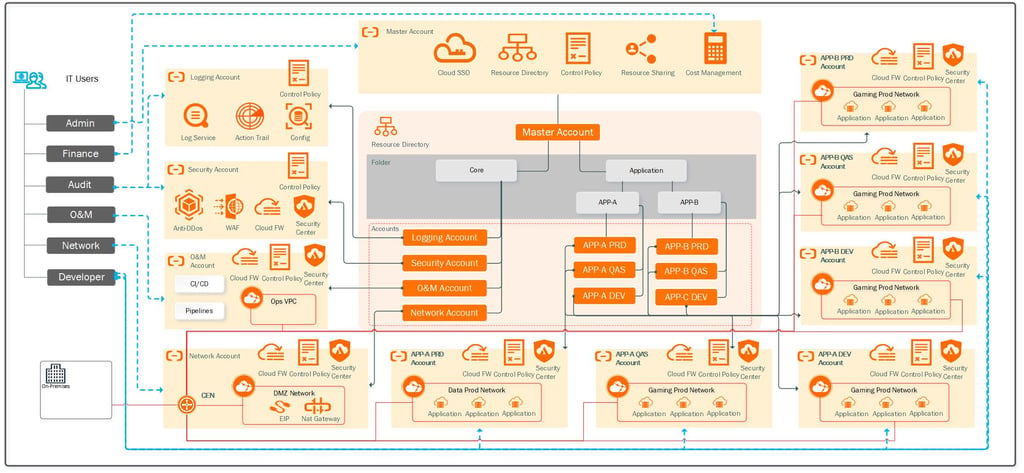Alibaba Cloud Landing Zone
Alibaba Cloud Landing Zone offers a blueprint for building secure and efficient cloud environments on Alibaba Cloud. It covers aspects like security, resource management, cost control, and compliance.
ALIBABA CLOUD
Abhishek Gupta
5/8/20243 min read


Alibaba Cloud, a major player in the cloud computing, offers a comprehensive solution for enterprises migrating to their platform: the Alibaba Cloud Landing Zone. This blog post dives into the technical nitty-gritty of the Landing Zone, exploring its components and how they benefit your cloud journey.
What is the Alibaba Cloud Landing Zone?
Think of the Landing Zone as a blueprint for establishing a secure, efficient, and well-governed cloud environment on Alibaba Cloud. It provides a foundational framework encompassing various aspects of cloud management, including:
Identity and Access Management (IAM): Regulate user access and permissions within your cloud environment.
Resource Management: Plan, provision, and manage cloud resources effectively.
Network Planning: Design a secure and scalable network architecture for your applications.
Financial Management: Monitor and optimize cloud spending for cost control.
Compliance and Auditing: Ensure adherence to regulatory requirements and internal governance policies.
Security Protection: Implement robust security measures to safeguard your cloud infrastructure and data.
Operations Management: Automate routine tasks and streamline cloud operations.
Automation: Automate resource provisioning and configuration for faster deployments.
Benefits of Utilizing the Alibaba Cloud Landing Zone
By adopting the Landing Zone framework, businesses can reap a multitude of advantages:
Enhanced Security: The Landing Zone enforces security best practices, reducing the risk of vulnerabilities and breaches.
Improved Governance: The framework promotes a well-defined cloud governance structure for centralized control.
Cost Optimization: Landing Zone fosters resource optimization and cost management strategies.
Increased Efficiency: Automation capabilities streamline operations and expedite deployments.
Simplified Management: The Landing Zone provides a holistic view and centralized management of your cloud environment.
Technical Components of the Alibaba Cloud Landing Zone
The Landing Zone leverages a variety of Alibaba Cloud services to deliver its functionalities. Here's a glimpse into some key components:
Account Management: Centralized planning of the enterprise cloud account system is crucial. Landing Zone helps you create and manage accounts, ensuring business isolation and architectural scalability. By defining account hierarchies, you can organize resources effectively and control access permissions.
Resource Management: Efficiently designing and managing IT environments on the cloud is essential. Landing Zone assists in resource planning, including compute instances, storage, databases, and other services. It ensures optimal resource allocation, scalability, and cost-effectiveness.
Network Planning: Planning network architectures for the medium and long term is critical. Landing Zone helps you design robust and flexible networks. Consider aspects like VPC (Virtual Private Cloud), subnets, security groups, and routing tables. Proper network planning ensures security, performance, and ease of maintenance.
Security Compliance: Customizing cloud security systems to meet compliance requirements is a priority. Landing Zone provides guidelines for network security, data security, operation auditing, and configuration auditing. Implement best practices to safeguard your cloud infrastructure.
Cloud Cost Management: Designing a cost allocation system is essential to track cloud computing costs. Landing Zone allows you to allocate costs across branches, departments, and projects. Monitor usage, optimize spending, and avoid surprises on your cloud bill.
Benefits of this Structure:
Enhanced Security: Separating accounts and resources minimizes the impact of a security breach.
Improved Organization: The folder structure provides a clear and organized way to manage resources for different applications and environments.
Granular Access Control: Teams only have access to the accounts and resources they need, reducing the risk of accidental misconfigurations.
Additional Considerations: This is a sample structure, and you can customize it based on your specific needs.
The Alibaba Cloud Landing Zone offers a compelling solution for businesses migrating to the Alibaba Cloud platform. It establishes a secure, well-managed, and cost-effective foundation for your cloud infrastructure. By leveraging the Landing Zone's framework and services, enterprises can streamline cloud adoption, optimize operations, and focus on core business objectives.


Sample Alibaba Cloud Landing Zone Structure
The Alibaba Cloud Landing Zone recommends a multi-account structure to enhance security and organize resources effectively. Let's break down the typical account types and folder hierarchy:
Accounts:
Master Account: This is the central account with overall administrative privileges. It should be used cautiously and for critical tasks only.
Logging Account: Dedicated for logging and monitoring activities, isolating logs from other accounts.
Security Account: This account manages security configurations and tools, ensuring separation of duties.
O&M Account (Operations and Maintenance): Used for managing and maintaining cloud infrastructure.
Network Account: Responsible for network configuration and management.
Application Accounts: Separate accounts for each application (App-A, App-B, etc.) for granular control.
Folder Hierarchy:
Top Level Folders:
Core: This folder stores shared services used by multiple applications, such as databases or authentication services.
Application: This folder holds individual application resources. Each application has its subfolders:
PRD (Production): Stores resources for the deployed production environment.
QAS (Quality Assurance/Staging): Contains resources for testing and staging purposes.
DEV (Development): Holds resources used by developers during the application creation process.
